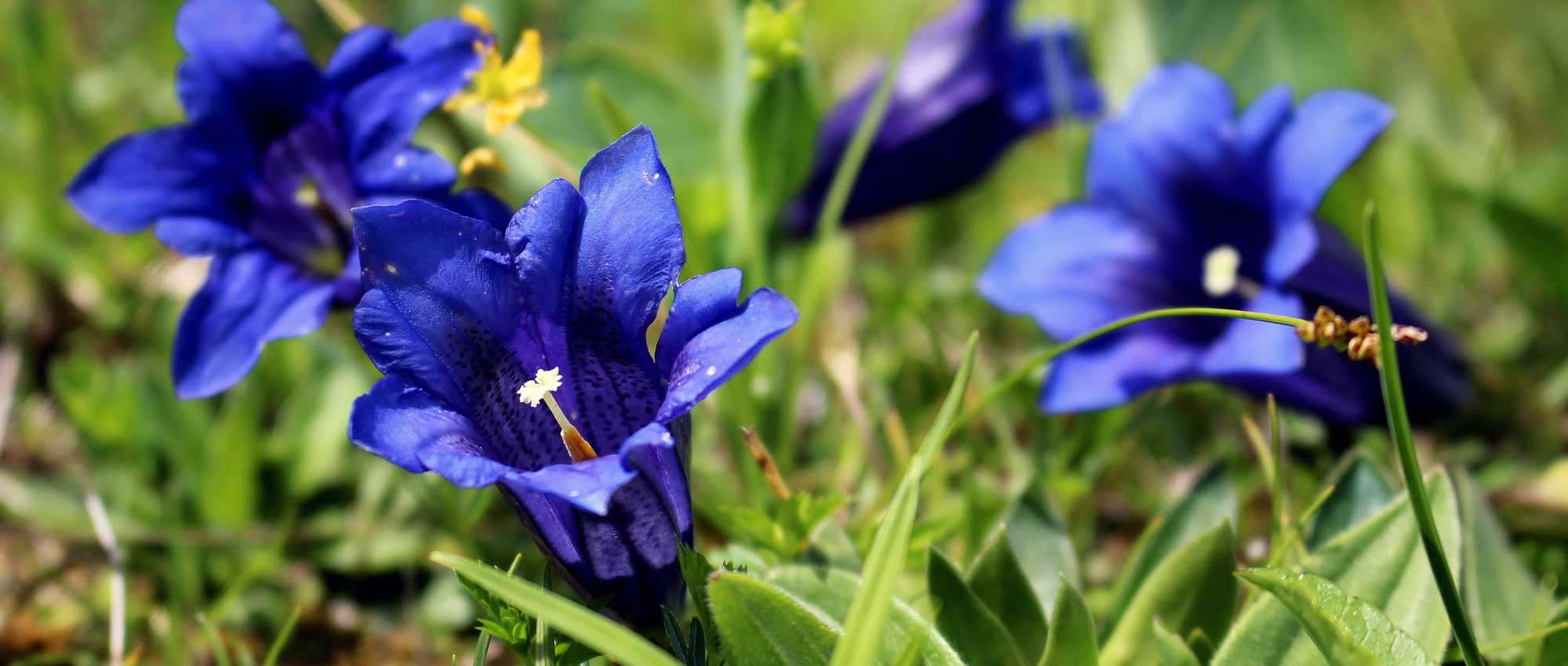
Gentian: planting, growing and care
Contents
Gentian in a nutshell
- Gentian offers a remarkable trumpet-like flowering
- The colours are splendid: often an intense and deep blue, sometimes also yellow or red-pink
- Gentian is an alpine plant, ideal for rockeries!
- There are small tapetum species and large gentians with an upright habit
- They bring a lot of colour to borders and rockeries
- Some species adapt very well to pot cultivation
A word from our Expert
Gentians are plants valued for their trumpet-shaped flowers, often blue or yellow. There are also a few species with white, pink, or red flowers. Their flowering can occur in spring, summer, or autumn. The leaves are green, entire, and opposite. The yellow gentian, Gentiana lutea, whose root is used to produce liqueurs and aperitifs, is perhaps the best known. It is tall and bears bright yellow flowers. However, there are also many species of gentians that form small carpets of green leaves on which magnificent blue trumpets stand out. This is the case, for example, with Gentiana acaulis.
Gentians can be planted in full sun or partial shade. However, avoid scorching situations, such as full sun during the hottest hours of the afternoon. Ideally, they should be planted in well-draining soil that remains cool in summer. The gentian fears stagnant moisture in winter. It is a very hardy plant that requires little maintenance.
Botany
Botanical data
- Latin name Gentiana sp.
- Family Gentianaceae
- Common name Gentian
- Flowering between May and October
- Height between 10 cm and 1.50 m
- Exposure sun or partial shade
- Soil type cool, draining, humus-bearing, neutral or slightly acidic
- Hardiness around -20 °C
The gentians comprise between 360 and 400 species of perennial, annual, or biennial plants. They are emblematic of the mountains and alpine regions. They are mainly found in the temperate regions of Europe, Asia, and America. Many species grow in our mountains, in the Alps, the Pyrenees, and the Massif Central. These are often protected plants. In nature, they can be found in crevices between rocks, in rocky areas, in meadows, and at the forest edge. Due to their alpine origins, gentians are very hardy plants.
The gentian gave its name to the family Gentianaceae, which includes nearly 1,700 species. These are often herbaceous plants, with regular flowers and fused petals. Two genera are very close to gentian: Gentianella and Gentianopsis. The gentian, however, has no relation to the plant known as the “Gentian tree” , Solanum rantonnetii.
The yellow gentian (Gentiana lutea) is often confused with veratrum, which grows in the same environments. It differs by its opposite leaves (in veratrum, they are alternate). These species are easier to recognise when in bloom: the flowering of the gentian is yellow, while that of veratrum is white.
The gentian is named after Gentius (2nd century BC), the last king of Illyria (present-day Albania) who discovered the tonic properties of the plant.
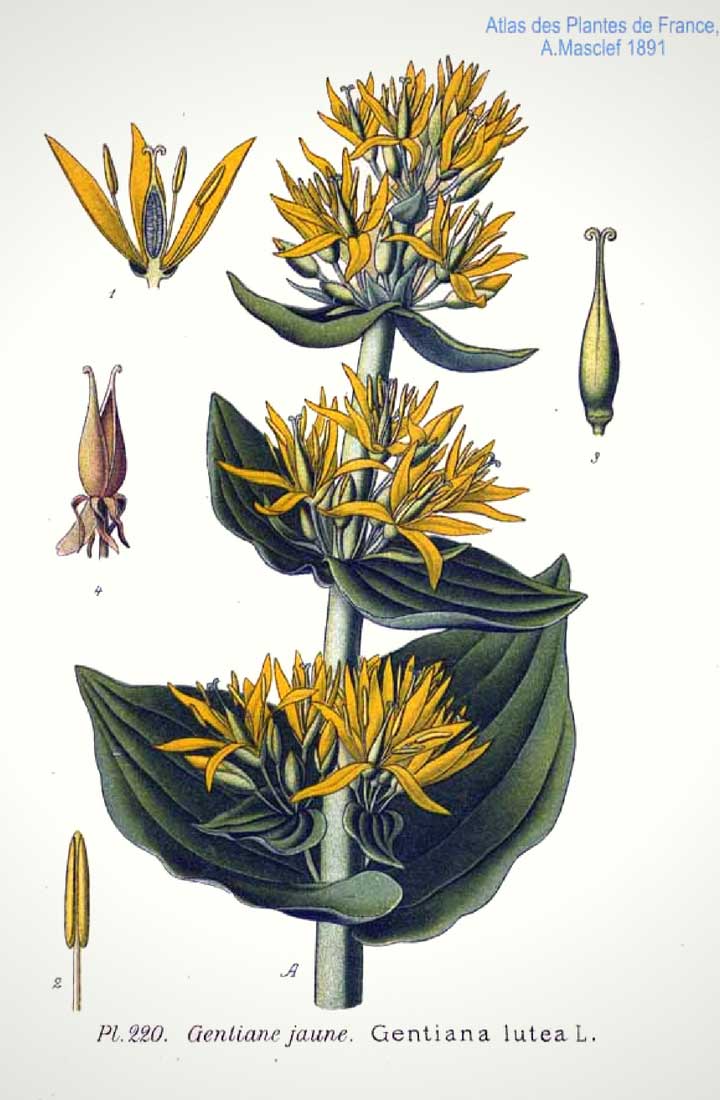
Gentiana lutea: botanical illustration
The height of gentians varies greatly, from small species with a spreading habit (Gentiana sino-ornata, Gentiana acaulis…) that often measure less than 10 cm tall, to the tall Gentiana lutea, which has a very vertical and rigid habit, and can reach 1.50 m! Gentiana lutea has a very straight, thick, and unbranched stem. Gentians are slow-growing plants. Gentiana lutea needs several years before it starts to flower. But once it does, it can live for a very long time, several decades!
Depending on the varieties, flowering occurs between May and October. There are thus species that flower in spring (like Gentiana acaulis), summer (Gentiana lutea), or autumn (Gentiana sino-ornata). It is therefore possible to combine different species so that their flowering periods succeed each other, allowing for longer enjoyment.
Flowers can be solitary; this is often the case with small spreading gentians found in rock gardens. They can also be gathered in dense whorls, grouped at the axil of the leaves, as seen in Gentiana lutea.
The flowers are easily recognisable by their trumpet shape. They are large and wide, especially when compared to the rest of the plant. They often measure between 3 and 5 cm in length. The corolla generally has five fused lobes forming a flared tube at the end, and is more or less plicate in length. Small lobes sometimes intersperse between the larger ones (particularly visible in Gentiana pyrenaica, which thus bears stunning ten-lobed flowers). In Gentiana lutea, the lobes are well divided, almost to the base. The tube of the corolla (petals) is inserted into a calyx made up of five fused sepals. Gentian flowers are hermaphroditic, possessing both male (stamens) and female (pistil) organs.
The flowers impress with the intensity and depth of their often blue hue. There are also species with a very bright yellow, such as Gentiana lutea, but flowers can also be white (Gentiana algida), purplish-red (Gentiana purpurea), or pink (Gentiana ‘Little Pinkie’). Gentiana scabra ‘Royal Stripes’ is very surprising with its bicoloured flowers, featuring blue and white stripes.
The throat (the inside of the corolla tube) is often a slightly different shade, with streaks or spots. In Gentiana sino-ornata, it is streaked with purple and green – white. Gentiana punctata bears yellow flowers speckled with small darker spots.

Gentian flowers are generally blue or yellow, but there are also horticultural varieties with more original shades. Gentiana thunbergii (photo Alpsdake), Gentiana lutea, Gentiana ‘Little Pinkie’ and Gentiana ‘Royal Stripes’
In gentians, leaves can be arranged in a basal rosette. However, on the stems, they are generally opposite, in pairs, and distributed very regularly.
The leaves are green but can also take on a slightly bluish hue. They often have an oval or lanceolate shape and can be very wide, as in Gentiana lutea, or conversely very narrow and linear, as in Gentiana sino-ornata. The leaves are entire, not lobed. They have well-marked parallel veins… particularly in Gentiana lutea, which gives them a plaited appearance! Leaves can measure up to 5 cm long in spreading gentians, while they reach between 20 and 30 cm long in the tall Gentiana lutea!
The leaves of Gentiana lutea resemble those of Veratrum, which leads to frequent confusion, especially since both plants grow in the same natural environments. However, the leaves of the gentian are opposite, while those of veratrum are alternate, which makes them easy to differentiate. While the yellow gentian is medicinal, veratrum is toxic.
Gentians can be deciduous or evergreen. In some species, the flowering stems disappear in autumn, and the plant retains only rosettes of leaves at ground level, which persist through winter.
The yellow gentian, Gentiana lutea, has a fleshy, thick root. It is harvested and used to make aperitifs, liqueurs, and spirits. It has a bitter taste and is medicinal, tonic, effective against fever, digestive problems…
The fruit of the gentian is a capsule. It is a dry fruit that splits into two parts when ripe, releasing the seeds.
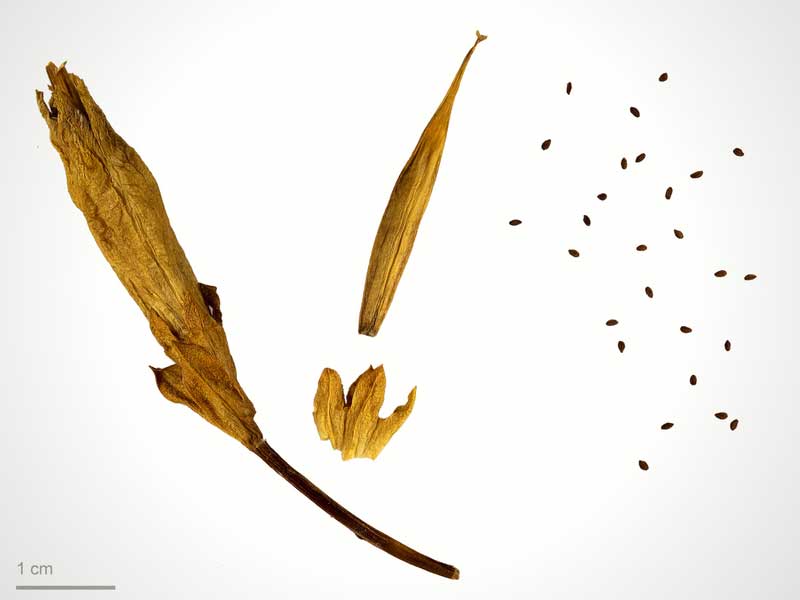
Gentiana alpina: fruits and seeds (photo Roger Culos – Museum de Toulouse)
The main varieties of gentians
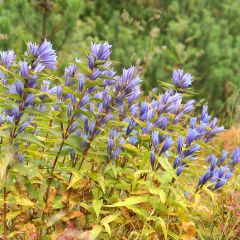
Gentiana asclepiadea
- Flowering time September, October
- Height at maturity 60 cm
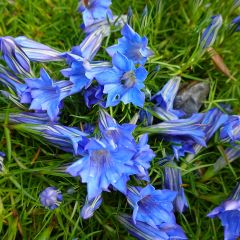
Gentiana sino-ornata
- Flowering time October, November
- Height at maturity 15 cm
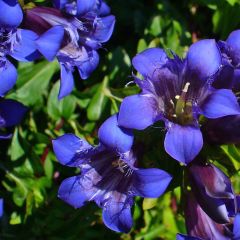
Gentiana septemfida var. lagodechiana
- Flowering time August, September
- Height at maturity 20 cm
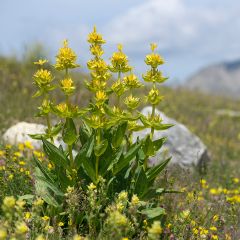
Gentiana lutea
- Flowering time July to September
- Height at maturity 1,20 m
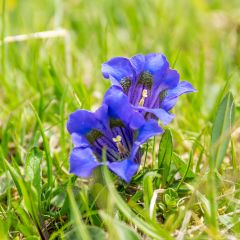
Gentiana acaulis
- Flowering time June, July
- Height at maturity 10 cm
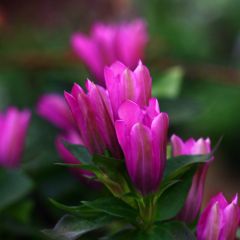
Gentiana Little Pinkie
- Flowering time July to October
- Height at maturity 15 cm
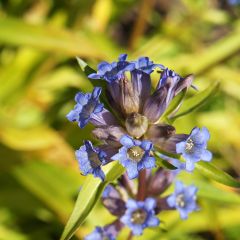
Gentiana dahurica
- Flowering time August to October
- Height at maturity 25 cm

Gentiana scabra Royal Stripes
- Flowering time September, October
- Height at maturity 25 cm
Discover other Gentian
View all →Available in 2 sizes
Available in 1 sizes
Available in 1 sizes
Available in 1 sizes
Available in 1 sizes
Available in 1 sizes
Available in 1 sizes
Available in 2 sizes
Available in 1 sizes
Available in 1 sizes
Planting
Where to plant?
Gentians thrive in full sun or partial shade. If you live in a relatively cool region, you can plant them in full sun; however, in the south of France, gentians will appreciate being placed in partial shade. It is best to avoid full sun during the hottest hours.
Gentians have a reputation for being delicate to cultivate, as they are demanding regarding substrate and growing conditions. Gentiana septemfida var. lagodechiana and Gentiana acaulis are among the easiest.
Gentians prefer soils that remain cool in summer, but it is important that the ground is well-draining, as gentians do not like when moisture stagnates in winter. The substrate should be porous and light. Some species particularly enjoy cool soils, such as Gentiana asclepiadea. Similarly, Gentiana lutea will thrive if you place it near a pond.
Gentians appreciate fertile soils rich in humus. Most of them prefer neutral to slightly acidic soils. However, there are also species that prefer calcareous soils, such as Gentiana asclepiadea.
Gentians can be integrated into a rock garden, especially for the smaller, spreading species. Create a raised bed and add some large stones to form a rock garden. For example, choose Gentiana acaulis or Gentiana sino-ornata. You can also place them on a wall, between stones, creating small pockets with a bit of potting soil. Larger gentians will find their place in a border or a bed. Gentiana lutea is perfect in a naturalistic garden! Some gentians are ideal in pots or containers: this is particularly true for the ‘Royal Stripes’ and ‘Little Pinkie’ gentians. Finally, the yellow gentian is so imposing that it can be planted solitary, for example in a short grass meadow.
It is best to carefully choose the location for the gentian, as it does not like to be transplanted. However, if you need to do so, avoid intervening during its growth period to avoid disturbing the root system.
When to plant?
We recommend planting gentians at the beginning of spring, around April.
How to plant?
Maintain a planting distance of about 30 cm for the smaller species, and at least 60 cm for the larger ones.
- Start by working the soil to loosen it and remove weeds.
- Dig a planting hole two to three times the size of the root ball. You can place some gravel at the bottom to improve drainage.
- Gently remove the root ball from its pot, taking care not to damage the roots, and plant. You can slightly elevate the collar of the plant above soil level to prevent water stagnation at that spot.
- Replace the soil all around and firm it down with the palm of your hand.
- Water generously.
Continue to water in the weeks following planting.
If you are growing gentians in pots, plant them in a mix of potting soil, coarse sand, and gravel to ensure the substrate is well-draining.
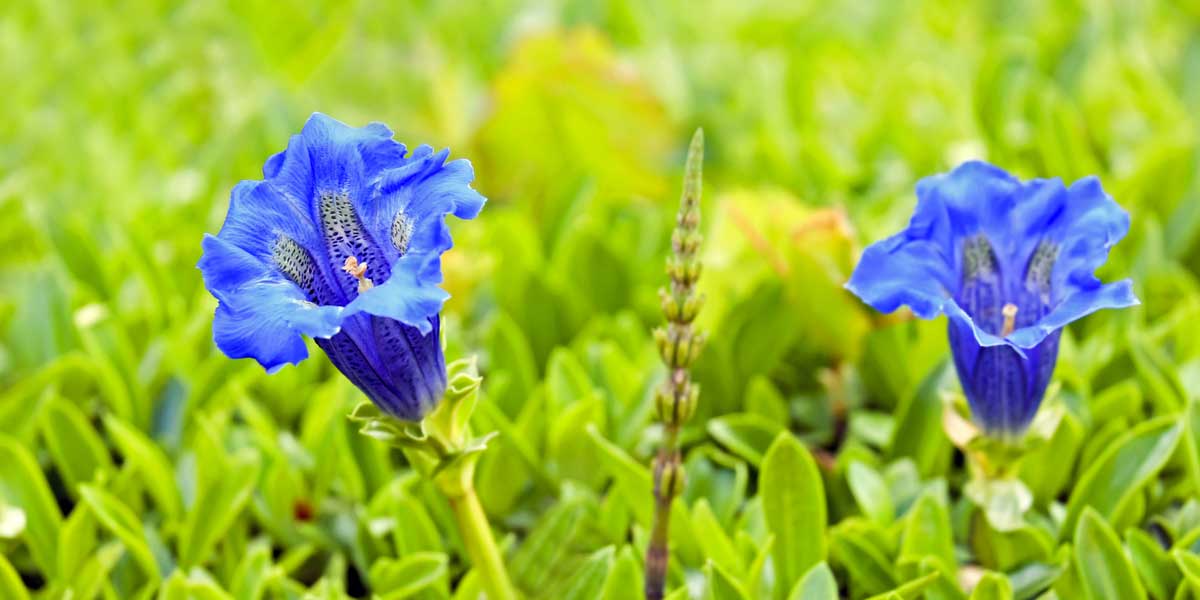
Care
Gentian requires little maintenance. It is unnecessary to provide it with fertiliser, but we advise you to water it in case of prolonged drought. Gentian appreciates soils that remain relatively cool in summer. However, it does not like wet ground in winter. If you are growing it in a pot, you can move it to shelter it from rain in winter.
You can remove the flowers when they have faded. This prevents the plant from dedicating its energy to producing seeds, instead encouraging it to produce new flowers. In autumn, we recommend cutting back the stems and leaves that have dried.
You can apply a layer of mulch at the base of your gentians, preferably organic (such as dead leaves, wood chips…) for larger species like Gentiana lutea, or mineral for smaller rock garden gentians. Mulching will help limit the growth of weeds.
Be cautious of slugs and snails that nibble on the leaves and young shoots. You can place a layer of sand around your gentians to prevent them from accessing it.
Gentian is also susceptible to rust. This disease is recognised by the presence of rust-coloured spots on the foliage. As soon as you notice its presence, cut away the damaged parts to halt its development, and treat with sulphur or a horsetail decoction.
Gentian is particularly sensitive to excess moisture, which can cause the root system to rot and lead to the appearance of fungal diseases. If you live in a rainy region, you may consider sheltering your gentians from rain in winter. Conversely, if you live in the south of France, during the height of summer, you may need to provide shade to protect the gentian during the hottest hours.
Propagation: sowing, division
Gentian can be propagated by sowing or division. Some species (Gentiana verna, Gentiana scabra…) can be propagated by propagation by cuttings of basal stems in late spring.
Sowing
It is preferable to sow in autumn, as soon as the seeds reach ripeness, because they are delicate to store and their seed viability is higher when fresh. Germination of gentian is quite irregular.
The seeds require a cold period to germinate (stratification to break dormancy). You can first place the seeds in a plastic bag, then in the refrigerator, for two months, and then sow them in pots at the beginning of spring. You can also carry out natural stratification by sowing in autumn and placing the pot outside for one to two months.
- Prepare a pot with special sowing compost, water it, and lightly firm it down.
- Place the seeds on the surface.
- Cover with a very thin layer of sand or sieved compost (a few millimetres is sufficient).
- Water gently using a spray bottle.
- Place the pot outside, as the cold promotes germination.
- You can cover the pot with plastic film or a glass plate to retain moisture.
Gentians are slow-growing plants. Once the seedlings have emerged, you can place the pot at a slightly higher temperature (maximum 18 °C). You can transplant the young seedlings in spring. When you transplant them, be careful not to damage the root system, which is quite fragile.
Division of Clumps
You can divide gentian in early spring. This technique is especially suitable for spreading species, such as Gentiana septemfida var. lagodechiana, and particularly for Asian gentians that flower in autumn. You can do this every three years.
Choose a well-developed plant and dig widely to lift it without damaging the root system. Divide the clump into two or three fragments, using a sharp knife if necessary, then replant and water generously.
→ Learn more about propagating gentian in Christine’s tutorial!
Using and combining Gentians in the garden
The small cushion gentians are ideal for bringing colour to a rockery! Feel free to combine them with phlox, aubrietas, Cerastium or Arabis caucasica… Enjoy the bright flowering of the carnations, such as Dianthus deltoides. Pair the spring gentians with the very delicate flowering of Anemone pulsatille! You can take this opportunity to create an alpine rockery. Choose for example Gentiana acaulis and combine it with other plants from our mountains, such as houseleeks, saxifrages, Edelweiss and androsaces! You can also install the gentians on a low wall, between the stones, with sedums, wall rue (Cymbalaria muralis), Campanula portenschlagiana, and even with small ferns (polypodies, Asplenium ceterach…)!

The gentian can integrate with other small plants in an “alpine garden” style rockery. Anemone pulsatilla (photo Marco Schmidt), Gentiana acaulis, Saxifraga paniculata (photo Der Messer), and Edelweiss (Leontopodium alpinum)
Gentians also allow you to create a naturalistic garden. Recreate a mountain meadow, as seen in the Alps! Combine them with knauties or scabious, eryngiums (Eryngium alpinum), fireweeds and white, light inflorescences in umbels (Chaerophyllum, Aegopodium…)! Also think of the delicate flowering of columbines, such as Aquilegia alpina. The yellow gentian, Gentiana lutea, is perfect for accompanying the superb Martagon lily! Add Veronicastrums, ferns, and large campanulas…
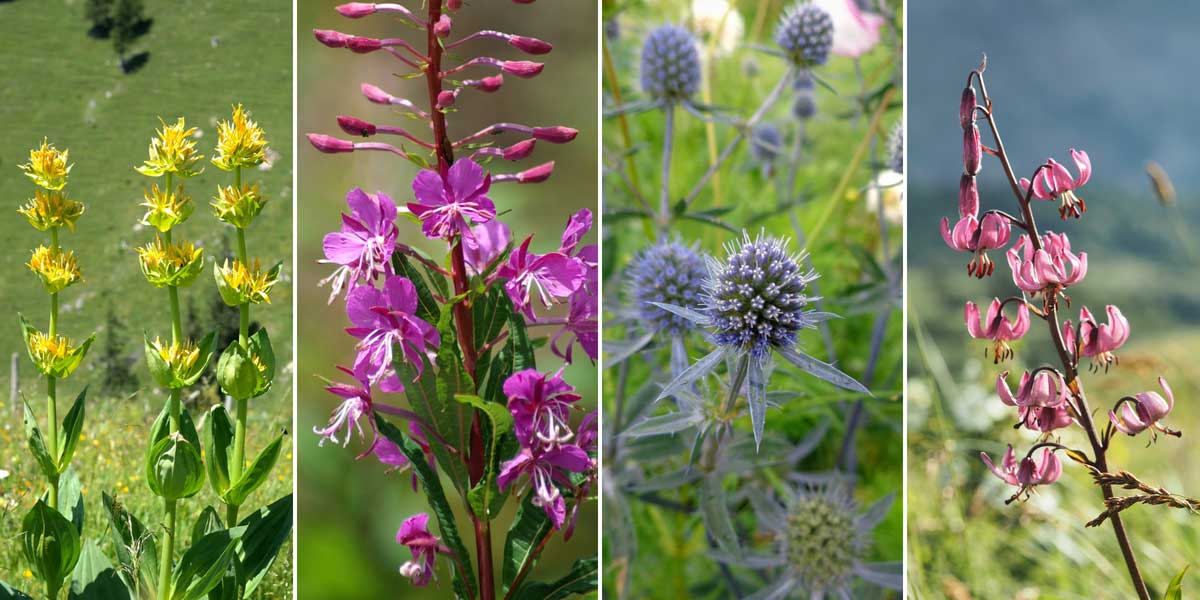
For a naturalistic style garden, or to create a flowering meadow! Gentiana lutea, Epilobium angustifolium (photo Böhringer Friedrich), Eryngium planum and Lilium martagon
As there are spring-flowering gentians, others that flower in summer or autumn, you can create beautiful scenes by combining them with plants that bloom at the same time! Thus, spring species, such as Gentiana acaulis, are perfect for accompanying spring bulbs: daffodils, tulips, muscari, star-of-Bethlehem, Dutch iris…
The great gentian, Gentiana lutea, can integrate into a very natural and colourful garden to create a summer border! It will allow you to design a mixed border with fairly free shapes. Plant it with fireweeds, veronicastrum, echinaceas, cosmos, agapanthus… And with the elegant flowering of foxgloves!
Autumn gentians will rather allow you to create a late-season scene, by combining for example Gentiana sino-ornata, with colchicums, dahlias, Sternbergia lutea, grasses and autumn foliage…
→ Discover more ideas for combining with gentian in our advice sheet.
Did you know?
- Yellow gentian: a useful, medicinal and aromatic plant
Yellow gentian, Gentiana lutea, is known for its fleshy root with a very bitter taste, which is often used to create aperitifs, liqueurs, and spirits. It is sometimes used to flavour beers, and gentian wine can also be made.
Gentian is primarily harvested in the Massif Central, the Alps, and the Pyrenees, between June and October. The roots are very thick and penetrate deeply into the soil. Their extraction requires the use of a special tool known as a “devil’s fork”.
The root of this gentian is renowned for its medicinal properties. It aids digestion, strengthens the immune system, calms the nervous system, is antiseptic, and tonic… It can be consumed as an herbal tea, or in the form of a decoction or tincture.
Frequently asked questions
-
The leaves of my gentian have orange spots! What should I do?
It is likely affected by rust, a cryptogamic disease (fungus). Generally, the upper side of the leaves bears discoloured spots, while the underside has powdery pustules, rust-coloured. The leaves may eventually fall off. Remove the affected leaves to prevent the disease from spreading. You can treat it by spraying a solution based on sulphur or a horsetail decoction.
-
The leaves and young shoots of my gentian seem to be nibbled!
The culprits are likely slugs and snails! They enjoy consuming the young leaves that are still tender. To create a barrier, you can lay down a layer of sand or sawdust around your young plants. Otherwise, use a slug deterrent such as Ferramol.
-
My gentian isn't flowering... Why?
Gentian is a slow-growing plant; it takes a long time to establish and, depending on the species, to start flowering. It is also an unpredictable and delicate plant; if the conditions are not suitable, it is likely to struggle to flower. Check that the growing conditions are appropriate, or consider relocating it.
- Subscribe!
- Contents
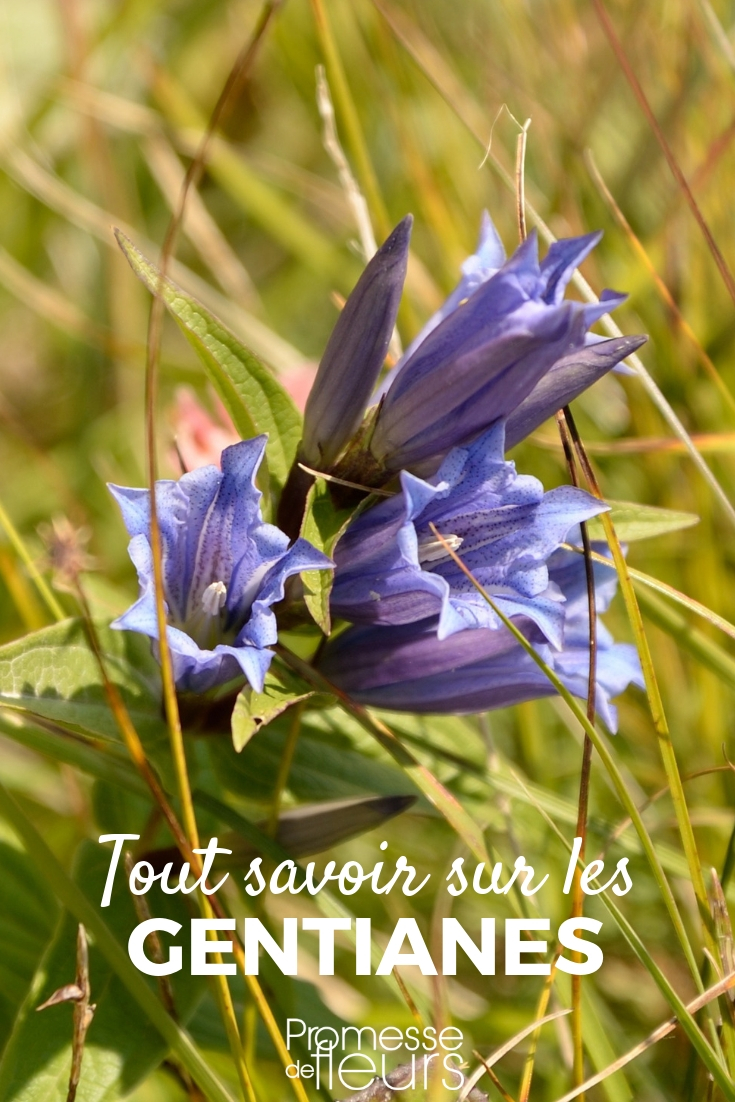
































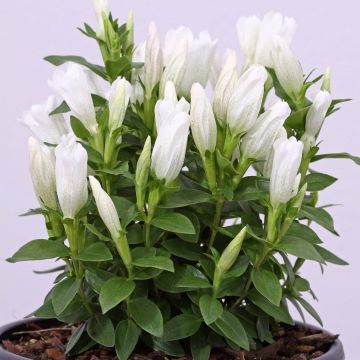
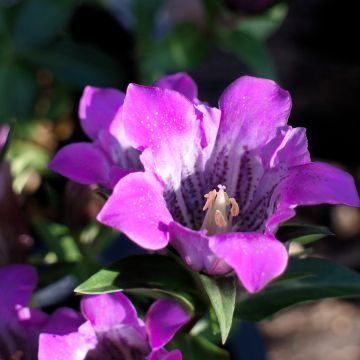
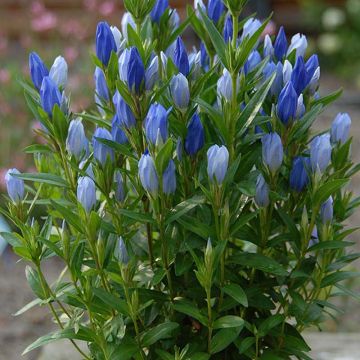
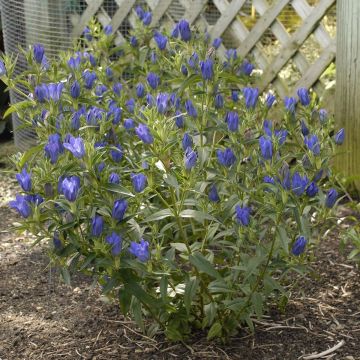

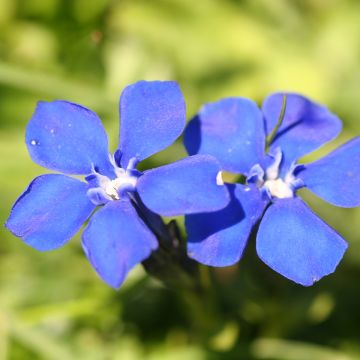

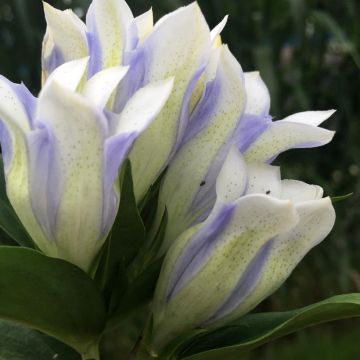
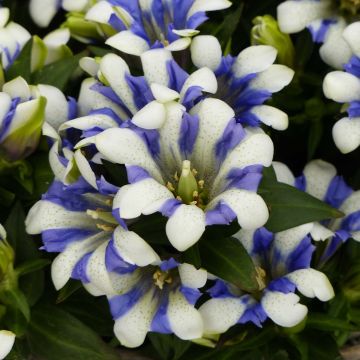
Comments